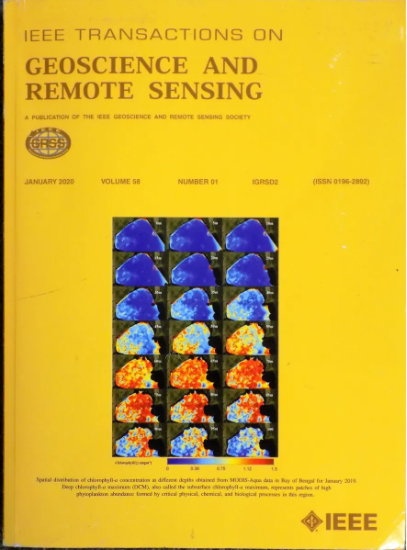IGroupSS-Mamba: Interval Group Spatial–Spectral Mamba for Hyperspectral Image Classification
IF 7.5
1区 地球科学
Q1 ENGINEERING, ELECTRICAL & ELECTRONIC
IEEE Transactions on Geoscience and Remote Sensing
Pub Date : 2024-11-18
DOI:10.1109/TGRS.2024.3502055
引用次数: 0
Abstract
Hyperspectral image (HSI) classification has garnered substantial attention in remote sensing fields. Recent mamba architectures built upon the selective state-space models (S6) have demonstrated enormous potential in long-range sequence modeling. However, the high dimensionality of hyperspectral data and information redundancy pose challenges to the application of S6 in HSI classification, suffering from suboptimal performance and computational efficiency. In light of this, this article investigates a lightweight interval group spatial-spectral mamba framework (IGroupSS-Mamba) for HSI classification, which allows for multidirectional and multiscale global spatial-spectral information extraction in a grouping and hierarchical manner. Technically, an interval group S6 mechanism (IGSM) is developed as the core component, which partitions high-dimensional features into multiple nonoverlapping groups at intervals, and then integrates a unidirectional S6 for each group with a specific scanning direction to achieve nonredundant sequence modeling. Compared with conventional applying multidirectional scanning to all bands, this grouping strategy leverages the complementary strengths of different scanning directions while decreasing computational costs. To adequately capture the spatial-spectral contextual information, an interval group spatial-spectral block (IGSSB) is introduced, in which two IGSM-based spatial and spectral operators are cascaded to characterize the global spatial-spectral relationship along the spatial and spectral dimensions, respectively. IGroupSS-Mamba is constructed as a hierarchical structure stacked by multiple IGSSB blocks, integrating a pixel aggregation-based downsampling strategy for multiscale spatial-spectral semantic learning from shallow to deep stages. Extensive experiments demonstrate that IGroupSS-Mamba significantly outperforms the state-of-the-art methods in classification accuracy and achieves lower model parameters and floating point operations (FLOPs). The code is available atIGroupSS-Mamba:用于高光谱图像分类的区间组空间-光谱 Mamba
高光谱图像(HSI)分类在遥感领域备受关注。最近建立在选择性状态空间模型(S6)基础上的曼巴架构在长程序列建模方面展现出了巨大的潜力。然而,高光谱数据的高维度和信息冗余给 S6 在 HSI 分类中的应用带来了挑战,其性能和计算效率都不尽如人意。有鉴于此,本文研究了一种用于高光谱分类的轻量级区间组空间-光谱曼巴框架(IGroupSS-Mamba),该框架允许以分组和分层的方式进行多向、多尺度的全局空间-光谱信息提取。在技术上,以间隔组 S6 机制(IGSM)为核心组件,将高维特征按间隔划分为多个非重叠组,然后为每个组集成一个具有特定扫描方向的单向 S6,以实现非冗余序列建模。与传统的对所有波段进行多向扫描相比,这种分组策略充分利用了不同扫描方向的互补优势,同时降低了计算成本。为了充分捕捉空间-光谱上下文信息,引入了区间组空间-光谱块(IGSSB),其中两个基于 IGSM 的空间和光谱算子级联,分别沿着空间和光谱维度表征全局空间-光谱关系。IGroupSS-Mamba 是由多个 IGSSB 块堆叠而成的分层结构,集成了基于像素聚合的降采样策略,用于从浅层到深层的多尺度空间-光谱语义学习。大量实验证明,IGroupSS-Mamba 在分类准确性方面明显优于最先进的方法,而且模型参数和浮点运算(FLOPs)更低。代码可在 https://github.com/IIP-Team/ IGroupSS-Mamba 上获取。
本文章由计算机程序翻译,如有差异,请以英文原文为准。
求助全文
约1分钟内获得全文
求助全文
来源期刊

IEEE Transactions on Geoscience and Remote Sensing
工程技术-地球化学与地球物理
CiteScore
11.50
自引率
28.00%
发文量
1912
审稿时长
4.0 months
期刊介绍:
IEEE Transactions on Geoscience and Remote Sensing (TGRS) is a monthly publication that focuses on the theory, concepts, and techniques of science and engineering as applied to sensing the land, oceans, atmosphere, and space; and the processing, interpretation, and dissemination of this information.
 求助内容:
求助内容: 应助结果提醒方式:
应助结果提醒方式:


